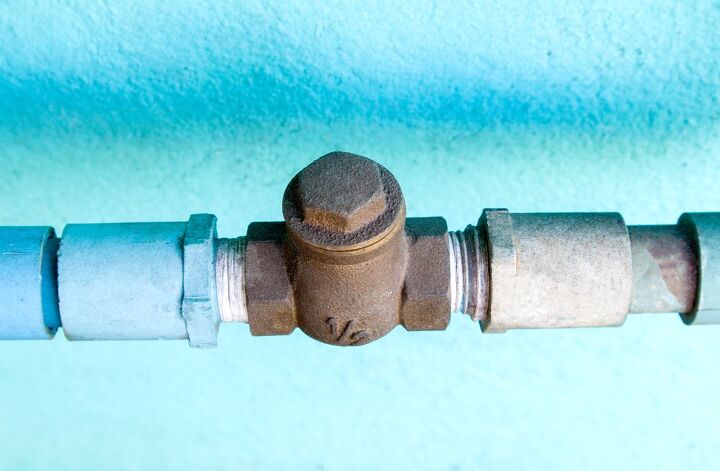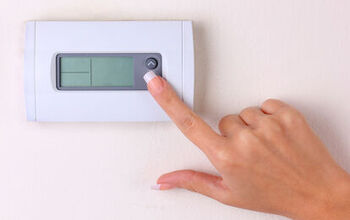7 Bad Check Valve Symptoms

Check valves are designed only to permit fluids to pass in one direction. If they fail, you’ll have issues since the liquids will flow in places they shouldn’t. You must first know how a check valve operates to analyze the symptoms that suggest something is amiss. Part of this is understanding the symptoms of a bad check valve.
Symptoms of a bad check valve include equipment failure, poor water flow, leaks, bad smells, noises, and visible wear of seals. A bad check valve can lead to failure of the valve, which can cause boiler explosions, water pressure problems, and water temperature problems. Fix the value as soon as you notice issues to save thousands of dollars.
In this article, we will talk about the symptoms of a bad check valve, as well as what leads to the issue. This information will help you avoid the problem. Let’s get started!
What Happens If a Check Valve Fails?
Given the widespread use of check valves in your household, you must do everything necessary to address any malfunctions as quickly as possible. Keep in mind that depending on where the check valve is located, it could have disastrous effects if it fails.
- Exploding boiler: A boiler explosion is possible if your check valves fail. It’s also worth noting that check valves that are damaged or malfunctioning might cause heating systems to explode.
- Issues filling washing machine: Breakdown of a check valve in your washing machine could affect the way fluid fills the machine if it fills at all.
- Temperature issues: It could also affect the temperature of the hot and cold water, as well as whether they mix. Furthermore, you may experience flooding issues.
The last thing you want to happen is for a check valve to fail. As a result, it’s a good idea to study why your valves fail so you’ll know what to look out for.
What Are the Symptoms of a Bad Check Valve?
If you have a problem with your check valves, you might notice a number of symptoms. The indications, on the other hand, will vary depending on why the valves have failed.
Equipment Failure
You may experience equipment failure if your valves break for any reason. You could wind up with a pump failure or an exploding boiler or hot water heater in that instance.
Your pipes may potentially burst, resulting in floods. When equipment fails due to a faulty one-way valve, expect to pay lots of money to repair it.
Poor Fluid Flow Symptoms
If there is a problem with the installation, you may discover that the fluid doesn’t really flow at all. This could occur if the contractor inserts the incorrect valve or in the incorrect orientation.
You may also notice that the volume of water or steam going through the valve isn’t what it should be. It could be a little less or a lot more.
If you have a problem with reduced pressure, you may indeed notice a reduction in the production of movement. These signals could appear in a variety of ways.
Leaky Symptoms
If you see leaking pipes from joints, pipe walls, or other connections, it’s a sign that there’s a serious problem. Such concerns can be caused by both water hammers and backward flow.
Leaks, on the other hand, usually indicate a long-term fluid pressure issue that must be addressed as quickly as possible because it has compromised the quality of your infrastructure.
Smelly Symptoms
If you smell unclean water, you may have a check valve problem. Water will back up in your basin, toilet, tub, or dishwasher if control valves in your drainage channels fail. Your nose will detect that wastewater.
If you have a boiler problem, you might smell rotten eggs, which means sulfuric gas is leaking. A metallic odor may also be present, indicating that deposits are accumulating anywhere in your boiler system, potentially even in your valves.
Heat And Energy Symptoms
If your energy costs are unusually high and you can’t figure out why it’s possible that your check valves are broken. Water heater and boiler valves are examples of this.
If your boiler check valves fail, for example, your system may circulate water throughout your home even if your thermostat is not programmed to send such commands. There could be a pressure problem that the valves are intended to fix but aren’t.
As a result, your power expenditures may dramatically increase. In addition, your home may become warmer than you prefer.
Noisy Symptoms
Water hammer problems are easy to spot since they make a pounding sound when the pumps are running. That could be due to the valve disc constantly opening and shutting as water passes through it.
If you hear sounds or feel vibrations in your plumbing while water runs, it’s possible that your check valves have broken or are about to fail. As a result, you should look more closely.
Visible Symptoms
When you inspect your valves, you see that they are stuck, which indicates that there is an issue that needs to be addressed. It may be as simple as greasing the valve components to solve the problem.
To get the valve to work properly again, you may need to clear some material. Sticking, on the other hand, could indicate age or corrosion.
Apparent wear and tear of parts such as seat seals is another indicator you may notice. In such circumstances, the components must be replaced. However, if the complete valve appears to be worn out, it will almost certainly need to be replaced.
Why Does a Check Valve Fail?
Check valves can fail for a variety of reasons, based on the appliance or drainage system. Here are a few of them:
Debris Within the Pipeline
Anything that shouldn’t be in the pipeline with fluids running through into the check valve is referred to as debris within the pipeline.
Any loose substance that enters the pipeline could wreak havoc on its internal workings. And if that happens, the valve as a whole could break, or its components may become dislodged and leak without you recognizing it until it’s too late.
Worn Out Valve Seat Seals
A check valve seat is an orifice that, when the proper pressure is reached, is closed by a ball or disc, prohibiting fluid passage in the wrong direction. To make the valve seats leak-proof, they are frequently encircled by gaskets, such as elastomeric rings.
These valves seals erode and wear out over time as a result of aging and friction. And they end up allowing some fluids to pass through, compromising their integrity.
The check valve fails as a result of this wear and tear. It may also allow fluids in partially or completely when it shouldn’t.
Low Fluid Pressure
Differential pressure is necessary for a one-way valve to function properly. The valve has a minimum operating range beyond which it cannot work.
If your valve isn’t working correctly, it could be due to a lack of flow. It’s possible that the conduit leading to it is overly wide or obstructed in cases when the water flow possesses low pressure.
If the pipeline is congested, for example, the water pressure may still not reach the required cracking pressure to release the valve since it slows down. As a result, your check valve can slow down the filling process in devices like the washer.
Low fluid pressure may also cause the diaphragm of the valve to relax. As time passes, the fluids going through the valve will subject it to excessive pressure, causing the components to wear down and fail.
Water Hammer
Fluids in a water hammer situation tend to stop or shift direction while in motion abruptly. Pump failure can result in such occurrences.
A pressure surge occurs as a result of this, which spreads throughout the pipe system and eventually collides with the check valves.
The pressure inside the system can be so high that it can destroy the check valves, pipe sidewalls, and other joints.
Poor Installation Techniques
The check valve’s performance is determined by the specialist you employ to install it. Check valves come in a variety of sizes and types. They also vary in terms of the kind of fluids they can hold or how well they work at various temperatures.
The valve’s flow capacity, appropriate orientation, and where to put the valve should all be known to the professional who executes the installation. That specialist must also choose a high-quality one-way valve that can tolerate wear and tear.
Reverse Flow
Reverse flow occurs when a pump fails, causing the water to decrease pressure and flow in the opposite direction.
As a result, the water waves slam into the pipeline, causing extensive damage to check valves, which might also fail to close or experience component erosion over time.
Poor Maintenance
Check valves must be maintained on a regular basis in order to function correctly. You may start by looking for evidence of excessive wear within the valve.
Determine whether you need to fix or replace the valve elements if they have deteriorated. Sometimes the answer is as simple as replacing worn-out seat seals with new ones.
Keep an eye out for line debris as well. If you see floating debris in your water or destination container, it’s possible that debris has become caught in the valve. The problem could be solved with a simple cleaning. The one-way valve, on the other hand, may need to be replaced.
It’s also possible that you’ll have to grease the valve components. On the other hand, other valves may require some insulating to function correctly.
High Temperatures
Temperatures that are too hot can possibly cause your check valve to malfunction. Valve components expand at high temperatures, lowering fluid pressure and compromising the internal dynamics.
Furthermore, high-temperature conditions may accelerate the deterioration of valve components, jeopardizing their capacity to be leak-proof. As a result, the speed at which water or gas flows through the valves will be slowed.

Heather is a passionate writer who loves anything DIY. Growing up, she learned everything from home repairs to design, and wants to share her tips with you. When she's not writing, she's usually hiking or searching for her next DIY project.
More by Heather Robbins












![10 Best Scroll Saws for 2022 [Ultimate Reviews & Buyer's Guide]](https://cdn-fastly.upgradedhome.com/media/2023/07/31/9070684/10-best-scroll-saws-for-2022-ultimate-reviews-buyer-s-guide.jpg?size=350x220)











![How To Reset A Whirlpool Cabrio Washer [In 5 Easy Steps!]](https://cdn-fastly.upgradedhome.com/media/2023/07/31/9076531/how-to-reset-a-whirlpool-cabrio-washer-in-5-easy-steps.jpg?size=350x220)


